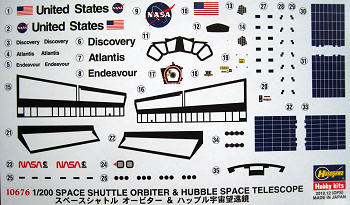Hasegawa 1/200 Space Shuttle and Hubble
Telescope
|
KIT #: |
10676 |
|
PRICE: |
120 RMB |
|
DECALS: |
Three options |
|
REVIEWER: |
Richard F |
|
NOTES: |
|

Newspaper cartoonists had a field day when the Hubble Space Telescope
first went into orbit in 1990. A tiny flaw in the telescope's mirror
meant the imagery wasn't nearly as awesome as scientists had hoped, or
expected. Three years later, a servicing mission saw astronauts fix the
telescope in a space walking tour de force. Subsequent servicing
missions improved Hubble's performance and prolonged its life right up
to the end of the Shuttle program.
The Shuttle's ability to fly a large payload and a large crew, and to
grapple an orbiting satellite so astronauts could perform maintenance,
made all this possible.
 Shuttles
varied in appearance over the years but the most obvious change was the
switch from the "worm" logo to the "meatball" logo in 1992/93. Shuttles
from the first mission in 1981 through to at least the end of 1993 wore
the 70s style NASA logo, which looks vaguely like a worm; shuttles after
that wore the familiar blue circle with a red swoosh on it, known as the
"meatball". Why anyone would want to eat a blue meatball is a mystery
for another day.
Shuttles
varied in appearance over the years but the most obvious change was the
switch from the "worm" logo to the "meatball" logo in 1992/93. Shuttles
from the first mission in 1981 through to at least the end of 1993 wore
the 70s style NASA logo, which looks vaguely like a worm; shuttles after
that wore the familiar blue circle with a red swoosh on it, known as the
"meatball". Why anyone would want to eat a blue meatball is a mystery
for another day.
The kit has the red worm appropriate for the telescope, but for the
shuttle, there is only the meatball. That means you can't build an
accurate model of either the Hubble launch mission (STS-31 Discovery
April 1990) or the first Hubble servicing mission (STS-61 Endeavour
December 1993). Both those shuttles wore the worm. Because the decal
sheet doesn't include names for Columbia (or Challenger), you also
cannot build the meatball-era Servicing Mission 3B STS-109 Columbia in
March 2002.
Without modification you can build the following Hubble-related missions
from this kit:
Servicing Mission 2 STS-82 Discovery February 1997
Servicing Mission 3A STS-103 Discovery December 1999
Servicing Mission 4 STS-125 Atlantis May 2009
As you can see, this means the Endeavour name on the decal sheet is
redundant, assuming you plan to build a shuttle-Hubble combo.
Apart from that, the kit is very nice for this scale. It has Hasegawa's
typical quality in engraved panel lines, and the surface details on the
Hubble telescope are quite nicely done. Some might say they are
over-emphasized but I think it will look good with silver foil smoothed
on top. Pictures show the telescope to be quite shiny, so I think that
will be the way to go.
Engine bells are always a point of contention on space shuttle kits.
These ones are ok, roughly bell-shaped I guess, and with some raised
detail. In 1/144 anyone half-serious about their shuttle would replace
the kit engines with resin from Real Space Models, but I don't think
there are resin replacements available for this kit. They'll do for me,
I think.
 The
kit also comes with a Spacelab for the payload bay. Given the lack of
worm logo and Columbia signs, I think that means the only accurate
out-of-the-box non-Hubble related model would be of STS-71 Atlantis.
Columbia seems to have done the majority of Spacelab missions with the
habitable pod, and the ones flown by other shuttles (apart from STS-71)
were all worm-era flights. But STS-71 was a cool mission, being the
100th US human spaceflight and the first Shuttle-Mir docking mission.
The
kit also comes with a Spacelab for the payload bay. Given the lack of
worm logo and Columbia signs, I think that means the only accurate
out-of-the-box non-Hubble related model would be of STS-71 Atlantis.
Columbia seems to have done the majority of Spacelab missions with the
habitable pod, and the ones flown by other shuttles (apart from STS-71)
were all worm-era flights. But STS-71 was a cool mission, being the
100th US human spaceflight and the first Shuttle-Mir docking mission.
The research set out above is pretty elementary. Doubtless there are
shuttle experts out there who know a lot more than I do about this
fairly esoteric topic. Help is to be found on the internet and various
model forums. But I've already decided to do mine as STS-125.
A neat kit, great for those who don't have room for a 1/144 or 1/72
Shuttle or who want a decent payload included in their kit. And for
those so inclined, probably a great foundation for a tricked-out build.
Richard F
September 2012
If you would like your product reviewed fairly and fairly quickly, please contact the editor or see other details in the
Note to
Contributors.
Back to the Main Page
Back to the Previews Index Page